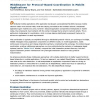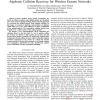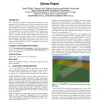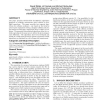IJRR
2008
14 years 1 months ago
2008
Safe autonomous flight is essential for widespread acceptance of aircraft that must fly close to the ground. We have developed a methodology of collision avoidance that can be use...
DSONLINE
2006
14 years 1 months ago
2006
We propose extending these middleware approaches with suitable abstractions to better support protocolbased interaction in mobile applications. To test our approach, we created Obj...
CORR
2010
Springer
14 years 1 months ago
2010
Springer
Current medium access control mechanisms are based on collision avoidance and collided packets are discarded. The recent work on ZigZag decoding departs from this approach by recov...
WISES
2003
14 years 3 months ago
2003
— This paper is about collision avoidance of crowd robots. For this purpose a model of potential field is proposed. This potential field, generated by a neural network, is uniq...
ATAL
2008
Springer
14 years 3 months ago
2008
Springer
The contribution presents a multi-agent technology in the domain of the air-traffic control of several autonomous aerial vehicles (manned as well as unmanned). The system has been...
ATAL
2008
Springer
14 years 3 months ago
2008
Springer
The paper proposes decentralized deconfliction algorithms deployed on multiple autonomous aerial vehicles in freeflight operations. The paper provides two separate algorithms for ...
SIGSOFT
1996
ACM
14 years 6 months ago
1996
ACM
In this paper we present our experiences in using symbolic model checking to analyze a specification of a software system for aircraft collision avoidance. Symbolic model checking ...
ICRA
1998
IEEE
14 years 6 months ago
1998
IEEE
This paper proposes a hybrid approach to the problem of collision avoidance for indoor mobile robots. The DWA (short for: model-based dynamic window approach) integrates sensor dat...
CDC
2009
IEEE
14 years 6 months ago
2009
IEEE
—We propose a tracking control with collision avoidance for a group of unicycle mobile robots. A supervisory system assigns to each robot its reference path, together with the de...
ICNP
2002
IEEE
14 years 6 months ago
2002
IEEE
This paper presents the first analytical model to derive the saturation throughput of collision avoidance protocols in multi-hop ad hoc networks with nodes randomly placed accord...




